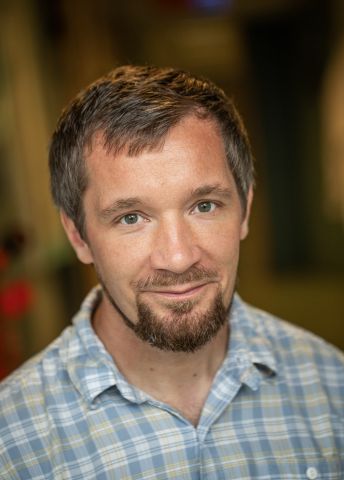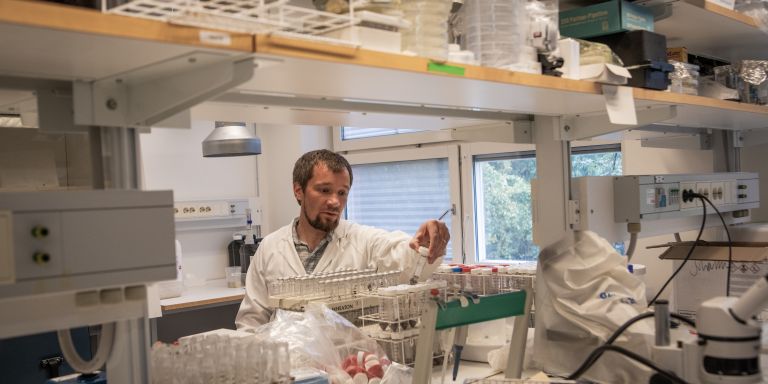
Johannes Rousk
Professor of Soil Microbiology
Wallenberg Scholar
Institution:
Lund University
Research field:
Microorganisms in soil, their metabolism and responses to environmental change


Wallenberg Scholar
Institution:
Lund University
Research field:
Microorganisms in soil, their metabolism and responses to environmental change
Microorganisms in soil take up nutrients, water and carbon, “exhale” carbon dioxide and are impacted by numerous environmental factors and interacting organisms. These processes fill Rousk’s days. He is a professor of soil microbiology at Lund University and a Wallenberg Scholar.
“I’m studying how microbes drive soil biogeochemistry, and my team is conducting field studies to determine how they impact land ecosystems.”
The main question is how microbial growth responds to change, and how this affects their uptake and release of carbon and nutrients. The fieldwork is conducted locally on a grassy patch of municipal land just behind the department, as well as in remote locations, in Abisko in the Swedish Arctic, or Costa Rica. The researchers collect soil samples and measure the composition and activities of microorganisms. They then build a roof over a small area to create a local drought, or intervene in other ways, e.g. by adding extra water, nutrients, salt or heat.
“In Abisko we recently simulated what would happen in an arctic climate during a summer heat wave, which did in fact happen naturally in Siberia that same year. Microbial communities can adapt their thermal traits to colder or warmer temperatures, and we wanted to test how quickly traits could respond to warming, and how long it would take to recover. It took fungi just over six months to recover, but bacteria more than a year. So carbon exchange between land and the atmosphere was impacted via lingering microbial traits long after the heat wave had ended.”
Climate warming does more than change the temperature. More heat means more drought, and also that more nitrogen is released through faster decomposition. Plant growth also increases, producing more leaves and more roots, which in turn impact the microbial environment. The researchers intend to delineate between the effects of individual factors. To do so, they are using control areas where they leave the temperature unchanged, but add extra nitrogen or leaves, for instance.
Rousk is not studying one species at a time; he is studying the impact of entire communities in their natural soil environment. The biogeochemical abilities of the microbial community are linked to the species composition of microorganisms by analyzing the genetic material.
“Our measurements are combined to form a performance curve that can be described with a mathematical function. In response to environmental change, we see the curve adapt, i.e. how the microbial community’s regulation of biogeochemistry correlates to the change. If we see similar responses in performance curves reflected in measurements from multiple soil ecosystems, this suggests that we have a robust finding. In that case the function describes how wild microbial communities respond to warming, drought or increased salinity, for example,” says Rousk.
“The microbes’ ability to store carbon appears to increase as a result of all types of simulated climate change.”
One discovery made by his team is that the microbes’ ability to store carbon appears to increase as a result of all types of simulated climate change he has studied so far. This was a surprise, since the earlier hypothesis was that soil would instead lose carbon as organisms increased their respiration, i.e. they release more carbon dioxide.
“They do – but their growth increase is greater, slowing the net release of carbon.”
One goal of the project is to find biomarkers to identify soil microbial communities with traits that are adapted to warm and cold conditions, respectively. This is a major task, but Rousk believes that one way of achieving it might be to link the mathematical functions describing microbial growth and biogeochemistry to a detailed survey of the genetic material from samples differing in respects other than temperature, such as pH and nutrient content. This will help reveal small differences that are characteristic for the different types of communities.
“I think the very best thing about research is that it’s curiosity-driven. You never know how it’s going to end – things quite often turn out differently from expected in the field. The simulation at Abisko of the extreme heat wave was originally intended to be a normal warming experiment, but our lamps were too powerful. But fortunately, it turned out that the lamps exactly matched the weather in Siberia that particular year. We were incredibly lucky – a happy accident that also enabled us to study the follow-up question of how the land ecosystem recovered from the heat-induced disturbance.”
Rousk enjoys it most when the team’s findings are not what they expected – when they realize they have measured in the wrong way or have not taken all factors into account. This is when the researchers begin to think along different lines.
He was originally drawn to soil microbiology by his childhood interest in space travel. He read science fiction novels by Isaac Asimov and began to ponder over what could be taken and what would be needed to create sustainable food systems on a colony on Mars.
“I’m still interested in truly minimalistic systems. Right now I’m planning to recruit someone for lab work on simplified systems with fewer species. We want to see how a lack of competition impacts growth-temperature optimization. In that case organisms can make different choices without losing out. But do they, or has evolution taught them to always make the same choices? It’s going to be very interesting to find out.”
Text Lisa Kirsebom
Translation Maxwell Arding
Photo Åsa Wallin